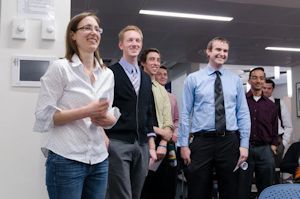Virtual Rehabilitation Designed to Aid Stroke Therapy Patients
Author: Amber Harmon - International Science Grid this Week
Published: 2014/04/18 - Updated: 2020/02/04
Category Topic: Rehabilitation and Hospitals - Academic Publications
Page Content: Synopsis - Introduction - Main
Synopsis: Winning TechSandbox competition team develop virtual reality game that provides real-time feedback to patients undergoing stroke therapy.
Introduction
Rehabilitation helps stroke survivors relearn skills that are lost when part of the brain is damaged. For example, these skills can include coordinating leg movements in order to walk or carrying out the steps involved in any complex activity.
Main Content
The goals of rehabilitation are to help survivors become as independent as possible and to attain the best possible quality of life.
The TechSandbox competition, coordinated by the University of Washington's Center for Sensorimotor Neural Engineering (CSNE), in Seattle, US, was so successful in its inaugural year that the competition now takes place within the framework of a two-credit-hour course offered through the department of bioengineering.
This year's winning team developed a virtual reality game that provides real-time feedback to patients undergoing stroke therapy.

Team vHAB - including two graduate students in bioengineering;
- An undergraduate in bioengineering,
- An undergraduate in neurobiology and behavior - created six games for stroke therapy patients.
vHAB uses muscle activity sensors to measure and speed up patient motor recovery, and delivers the data into electronic medical records so doctors can measure stages of both clinical and at-home recovery.

"The competition began as a way to engage students and faculty, and entice them to visit the center and experience, hands-on, the equipment that is available," says Lise Johnson, researcher and education manager at the US National Science Foundation-funded CSNE.
"As the course has evolved, we've seen the students focus on wearable technologies, consumer devices, and medical devices; our panel of industry liaison judges has been very impressed by what the students are capable of."
Attribution/Source(s): This quality-reviewed publication was selected for publishing by the editors of Disabled World (DW) due to its relevance to the disability community. Originally authored by Amber Harmon - International Science Grid this Week and published on 2014/04/18, this content may have been edited for style, clarity, or brevity.